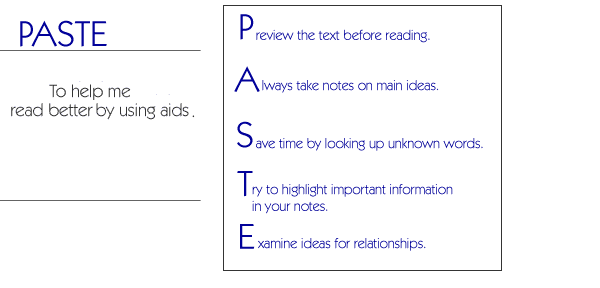|
Preview the text before reading.
- Always look over the pages you have to read before you start
reading.
- Focus on headings and subheadings first.
- Also focus on words that are in boldface or have definitions
in parentheses.
|
 |
|
A lways take notes on main ideas.
- Write down main ideas and important facts on note cards so that
you can study these in the future.
|
 |
|
S ave time by analyzing unknown words.
- If you do not know the meaning of a word, try to figure it
out using context clues. If this doesn't work, look it up in
the glossary or a dictionary.
- If you think that this is an important word, write it on the
front of a note card and the definition on the back.
|
 |
|
Try to highlight important information.
- If you own the book you are using, highlight the important ideas.
If you find highlighting helpful in understanding a book and the
book is not your property, photocopy the pages and highlight them.
- If you do not own the book and have taken notes on what you
have read, then highlight the important ideas in your notes.
- NEVER HIGHLIGHT EVERYTHING. The idea behind highlighting is to identify the most important information. If you highlight everything, you will not be able to pick out the most important information.
|
 |
|
E xamine ideas for relationships.
- As you read, try to think about the "big picture."
Try to figure out how the information you are reading is related
to other information on this topic.
- Try to think about what you have read before on this topic.
- Use graphic organizers to help you show these relationships.
For example, if this chapter contains causes for events described
in previous chapters, use cause and effect graphic organizers
with arrows going from the causes to the effects.
|
 |







